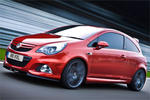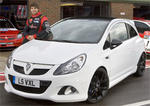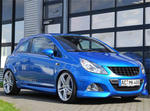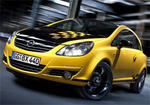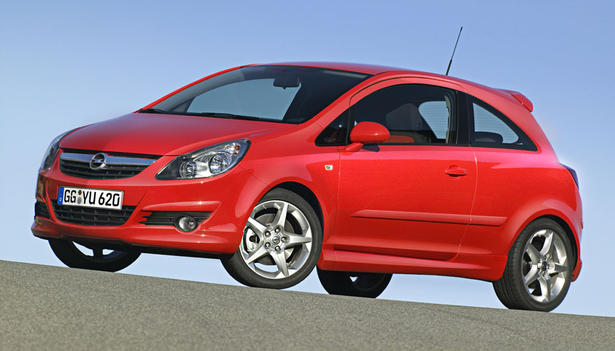
The Opel Corsa turns 25 this year and 10 million of them have been sold in Europe since its launch in 1982.
Opel released today detailed information on the new Opel Corsa GSi. The new Opel Corsa GSi is powered by a 1.6 liter ECOTEC turbo engine that develops 110 kW/150 hp at 5000 rpm.
The new Opel Corsa GSi has a top speed of 210 km/h and 100 km/h comes in 8.1 seconds. The new Corsa GSi is also equipped with Electric Power Steering (EPS) with variable progressive feedback curve and a sporty tuned ESPPlus as standard.
Opel Press Release:
Opel Corsa GSi: Synonym for Sportiness Since 1987
- 1987: First Opel Corsa GSi with 98 hp presented
- 1994: Corsa B GSi with 109 hp and metal catalytic converter
- 2001: Corsa C GSi produces 125 hp and exceeds 200 km/h barrier
- 2007: Corsa D GSi with 150 hp and choice of three or five-door variant


Rüsselsheim. Opel’s ‘GSi’ title has a tradition dating back to 1984, when a 115 hp Kadett E first bore the three letters. Thanks to extraordinary aerodynamics, this car could top 200 km/h. Its success prompted Opel to include a sporty high-performance GSi variant in the Corsa range, beginning in 1987. The continuing motto through Opel Corsa GSi models has been ‘more substance than show’ – their sportiness is radiated subtly, rather than aggressively and uncompromisingly.
Opel Corsa A GSi: Success story begins
The Opel Corsa GSi’s success story began in Frankfurt at the 1987 IAA Motor Show. Opel had already been building Corsa A models at its new plant in Zaragoza, Spain since 1982. The Corsa A’s three-door, 3.62-meter long body with flared fenders at the front and rear axles practically predestined it for a sporty makeover. Initially, the Corsa A was available with an engine range from 1.0 to 1.3 liters, and output from 45 to 70 hp. But the Corsa GSi Opel presented at the IAA in 1987 would change that dramatically. The three-door Corsa A’s typical flared wheelarches, which in the basis version were usually filled with rather diminutively sized 135 SR 13 tires, now featured
much more befitting and impressive 175/65 HR 14 tires with distinctive three-spoke light alloy rims. The key difference was the engine, however – a 1.6-liter four-cylinder unit with cross-flow cylinder head and state-of-the-art air-flow controlled Bosch Motronic gasoline injection. The standard Corsa variants still had downdraft carburetors at that time. The advanced gasoline injection also enabled the 1.6-liter engine to use a three-way catalytic converter.
Especially important for GSi fans was that the 98 hp engine produced a top speed of 186 km/h, thanks in no small part to improved aerodynamics (cD=0.35). Although this may not seem so spectacular today, at that time it set standards in its segment. The front-wheel drive
Corsa A’s chassis easily handled the GSi’s increased output: the McPherson strut front axle, torsion beam rear suspension, front and rear stabilizers, front disk brakes and rear drum brakes were all a great match and enabled plenty of driving fun – particularly as the GSi weighed just 865 kg in those days. Fuel economy was also impressive: just 7.3 liters of super unleaded fuel per 100 kilometers. The Opel Corsa GSi had its market launch in 1988 and over 55,000 were sold up to 1993 in Western and Central Europe.
The unveiling of the first Opel Corsa GSi variant came around six years after the Corsa A was launched, though Opel did not wait as long to present the GSi variant of the second-generation Corsa. Encouraged by the first GSi’s success, it was only a few months after the Corsa B’s premiere that the sporty Corsa B GSi joined the model line, at the end of 1993. This time, the GSi title was joined by 16V, highlighting that the 1.6-liter engine now had four valves per cylinder, two more than previously. This produced an output increase from 98 hp to 109 hp, and a torque boost from 132 Nm at 3400 rpm to 150 Nm at 3800 rpm. In addition to the new four-valve cylinder head, the further enhanced carburetion and electronically controlled multi-point injection with anti-knock control also contributed to the increase in output and torque. And instead of the usual ceramic catalytic converters, the Opel Corsa GSi 16V featured an especially efficient and heavy-duty metal catalytic converter for effective emissions control.
The Opel Corsa GSi 16V was around 11 cm longer than the first generation at 3.73 meters, which benefited rear passengers in particular. Although the greater length and enhanced safety measures (such as double steel tube reinforcements in the doors) did increase the vehicle’s weight by around 80 kg, the new GSi’s optimized aerodynamics, more powerful engine output and five-speed sport transmission enabled a top speed of 195 km/h. Despite increased output and weight, the second-generation Opel Corsa GSi’s fuel consumption fell to 7.2 liters per 100 km.
Opel Corsa C GSi: Tops 200 km/h
Fall 2000 saw the launch of the completely newly designed third-generation of Opel’s global bestseller. The top-of-the-line Corsa was again the GSi, this time with a 1.8-liter ECOTEC engine that produced 125 hp. This output, combined with sophisticated aerodynamics (cD=0.32), propelled the Opel Corsa GSi to a top speed of over 200 km/h for the first time. To easily control these driving dynamics, the GSi featured the new Dynamic Safety chassis (DSA) – the front axle was mounted to a particularly lightweight and robust hydroformed subframe. The torsion beam rear suspension had an increased load capacity, as well as stabilizers with different roll rates. The result was more precise reactions to steering wheel movements and improved driving comfort. The brake system consisted of internally ventilated front disk brakes, large rear disk brakes and ABS, which optimally distributed braking power. To prevent the driving wheels spinning during heavy acceleration in poor driving conditions, such as through wet corners, the GSi featured Traction Control (TC) with brake and engine intervention.
Its further enhanced, yet typical Corsa design gave the GSi a grown-up and dynamic appearance. The now 3.82-meter long sporty model boasted a larger interior, noticeably increased shoulder room, comprehensive safety package and the longest wheelbase in its class with 2491 mm. The fully galvanized body was 33 percent more rigid than the second-generation GSi, contributing to the car’s top marks for passenger protection and quality. Customers in Western and Central Europe were very taken by this Opel Corsa GSi's qualities, and around 65,000 units were sold during its production cycle.
Opel Corsa D GSi: Available as three or five-door
On June 7, 2007, the fourth-generation Opel Corsa GSi made its world premiere at the Barcelona Motor Show. Now featuring a 1.6-liter turbo gasoline engine with 150 hp and 210 Nm of torque, the GSi has a top speed of 210 km/h and accelerates from zero to 100 km/h in 8.1 seconds. The Electric Power Steering (EPS) with variable progressive feedback curve and lowered sport chassis (front: 18 mm, rear: 15 mm) with ESPPlus as standard ensure extremely agile handling. And Opel Corsa GSi customers can choose between a three or five-door body variant right from the start. As with previous models, the new Opel Corsa GSi radiates subtle sportiness.
“Opel fans know just what the three letters GSi stand for: plenty of fun, good value for money and no compromises in everyday use,” says Alain Visser, Executive Director European Marketing Opel/Vauxhall, about the newest member of the Corsa model family. Following the launch of the extremely sporty Corsa OPC with 192 hp in spring 2007, he goes on to explain the top-performing Corsa ‘hierarchy’: “The order remains as ‘Sport’, ‘GSi’, and ‘OPC’ at the top. Although the 'Sport’ is more an equipment variant, the GSi is recognizable as high-performance variant. OPC is an individual label and stands for the top models in each of our model lines. With the OPC Line range, we offer our customers the opportunity to personalize the bodywork of their Opel car.”
Opel Corsa Gsi
Powerful Performance and Subtle Sportiness
- 150 hp turbo gasoline engine available for three and five-door models
- Constantly high torque over broad rpm range
- Variable progressive steering feedback curve provides sports car feeling
Rüsselsheim. The motto of the new Opel Corsa GSi, which joined the Corsa model line in June 2007, is ‘more substance than show’. Unlike the uncompromising high-performance look of the Opel Corsa OPC that was launched in March 2007, the new GSi radiates subtle sportiness, and is now available as a five-door variant. The GSi’s powerful 1.6 ECOTEC turbo engine produces 110 kW/150 hp at 5000 rpm, positioning the new sporty model between the Corsa Sport 1.7 CDTI with 92 kW/125 hp and the high-performance Corsa OPC with 141 kW/192 hp. It takes the new Corsa to a top speed of 210 km/h and accelerates it from zero to 100 km/h in 8.1 seconds. The lowered sport chassis, Electric Power Steering (EPS) with variable progressive feedback curve and sporty tuned ESPPlus as standard ensure agile handling.
“We’re pleased to again have another GSi model in our portfolio. Opel fans know what GSi stands for: plenty of fun, good value for money and no compromises in everyday use,” explains Alain Visser, Executive Director European Marketing Opel/Vauxhall. “The Opel Corsa GSi combines the virtues of its compact dimensions with impressive performance over the entire rpm range, which actually positions it in the next higher car class.” The successful Corsa model range now includes five gasoline and three diesel variants with a perfor-mance spectrum of 60 to 192 hp. Around 400,000 new Corsas have been sold across Europe since the fourth-generation’s launch in October 2006, surpassing all expectations.
1.6 Turbo ECOTEC: Lightweight compact engine
The 110 kW/150 hp, 1.6-liter turbo engine in the Opel Corsa GSi provides high performance combined with fuel economy and environmental compatibility. Weighing just 131 kg, the compact engine produces considerable power: the Opel Corsa GSi accelerates from zero to 100 km/h in 8.1 seconds and has a top speed of
210 km/h. In addition to the rapid turbo response, the engine with sequential manifold injection boasts excellent elasticity – the GSi accelerates from 80 to 120 km/h in just 8.2 seconds in fifth gear. The maximum torque of 210 Nm is available constantly from 1850 to 5000 rpm which, together with the six-speed manual transmission, forms a key part of the GSi’s impressive driving performance. The Opel Corsa GSi requires just 7.9 liters of super unleaded gasoline per 100 kilometers – a very low figure for such a sporty car.
The clever, lightweight construction is an important characteristic of the standard engine. Including the aluminum bearing cover, the grey cast iron block weighs only 27 kg. The cylinder head, oil sump and turbo-specific induction manifold with side-mounted throttle valve are all made from aluminum. Other construction highlights of the GSi’s turbo engine, which has a remarkable output per liter of 94 hp, include a rapid-response compressor with external water cooling. Its turbine reaches over 200,000 rpm. The turbocharger housing is integrated into the cast exhaust manifold an Opel-typical design that is optimal for the weight and rapid response of the turbocharger. Other features include the air-cooled intercooler, exhaust valves that are cooled by sodium in the shaft and oil-spray cooling of the flat pistons. There is also the stronger crankshaft drive, friction-optimized operation of the camshafts and the new two-mass flywheel with torsional-vibration damper that improves running smoothness.
The unit is also well suited for the future. The preconverter directly behind the turbine outlet supplements the main underfloor catalytic converter and improves the quick response of the three-way exhaust emission control. Together with the new hybrid technology engine control unit, it is perfectly positioned to meet all requirements of the upcoming Euro 5 emissions standard.
Sporty tuning of steering, chassis and brakes
The excellent driving dynamics and agile handling match the newest Corsa variant’s distinctive temperament. These characteristics are also typical of the fourth Corsa generation as a whole. The GSi’s Electronic Power Steering (EPS) responds variably, which enables easier maneuvering. The variable progressive feedback curve, which is unique in this class, provides a more direct response ratio at smaller
steering-wheel angles. Together with the dynamic chassis design, it provides a true sports car feeling. Other driving fun factors include the torsion-resistant body, which is 18 mm lower in front and 15 mm lower in the rear, as well as the chassis with front subframe and rear torsion beam. Just like the Corsa OPC, this gives the GSi variant a stronger rear axle profile, which increases the roll rate by 25 percent, and modified spring/dampener tuning. With the ABS and sophisticated ESPPlus system, the Opel Corsa GSi is always under control: in addition to brake assist, Electronic Brake Force Distribution (EBD) and Understeer Control Logic (UCL), separate Cornering Brake Control (CBC) and Straight-Line Stability control (SLS) functions are activated when needed. Experienced, sporty drivers can have even more driving fun by switching off the ESPPlus. The large 16-inch brake system from the Corsa OPC ensures strong deceleration: the Opel Corsa GSi boasts 25 mm thick, internally ventilated 308 mm front disk brakes and 264 mm disk brakes at the rear. Low-profile, size 215/45 R 17 tires on seven-inch light alloy wheels ensure optimum traction.
Sporty, refined looks
The Opel Corsa GSi design elements radiate sporty refinement. Exterior modifications include a front spoiler lip, rear apron lip and spoiler, color-keyed side sills, chrome sport tailpipe and 17-inch light alloy wheels. The interior’s dynamic ambience is emphasized by the comfortable, black/red upholstered sport seats with high side support, a leather steering wheel with red inserts, red safety belts,
chrome-ringed instruments and aluminum-look pedals.
The combination of easy-going GSi driving fun and ample equipment is highlighted by the extensive list of standard comfort and safety elements. This includes: front and rear head curtain airbags, active head restraints in front, air conditioning, tinted heat-absorbing glazing, radio remote control central locking, power heated exterior mirrors, power windows in front, backlit switches and displays, reading lamps, stereo CD-Radio CD 30 MP3 with steering wheel remote control, height-adjustable driver’s seat, height and reach-adjustable steering wheel, foldable rear bench seat back split 1/3:2/3, double luggage compartment floor, door-to-door lighting and fog lamps. Technology options available for the Opel Corsa GSi that are unique in this class include halogen headlamps with dynamic curve and static cornering light.
Opel Corsa Gsi – Technical Specifications
Engine 1.6 turbo ECOTEC
Emissions standard compliance Euro 4
Fuel super unleaded
Number of cylinders 4
Displacement in cm3 1598
Max. output in kW (hp) 110 (150) at 5000 rpm
Max. torque in Nm at rpm 210 at 1850 - 5000
Transmission 6-speed manual
Maximum speed in km/h 210
Acceleration from 0 – 100 km/h in seconds 8.1
Urban 10.5
Extra-urban 6.4
Combined 7.9
CO2 emissions in g/km 189
1982 – 2007: Four generations of successful model
Opel Corsa Celebrates 25th Birthday
- 10 million Corsas sold throughout Europe since 1982
- Extremely popular model around the world
- New Corsa continues success story
In 1982, the Opel Corsa’s global success story in Europe began when the supermini debuted in a segment that it would play a leading role in for years to come. The Corsa was the best-selling car in its class in Germany from 1995 to 2001 – a position it recaptured in the first half of 2007 – and also topped its segment in the United Kingdom in 2004 and 2005, achieving a market share of almost 16 percent. To date, 10 million Corsa models have been sold throughout Europe and over 18 million worldwide. However it is not just record sales that have dominated the Corsa’s 25-year career. Its progressive looks, innovative technology and sport successes are also very important factors. The new Corsa alone has won more then 20 international awards.
First generation: Success story begins
With the premiere of the Corsa in 1982, Opel entered new territory in many ways: a new model in a new segment for Opel, and a completely new plant for the Corsa in Spain. The production run for the first-generation Corsa, which was built solely in Zaragoza, lasted for just over ten years. The Corsa A propelled the European supermini segment to seven percent of total European sales by the end of 1983 and to more than 10 percent by the end of 1984. Automotive experts were quick to praise the new car, with the German automotive magazine ‘auto motor und sport’ describing its road behavior as “among the best available anywhere in this class today.” The Corsa A also broke new ground in car design and technology.
The car’s compact body and bold flared wheelarches were a real eye-catcher, and its highly economical engines were impressive for a car of that time: the entry-level 1.0-liter engine required just 6.6 liters of fuel per 100 kilometers. In addition to reliability, passive safety was a top priority in the Corsa A, and the small car was the first in its car class to have anti-submarining ramps in the front seats. After undergoing many updates and model additions over its ten-year life, including the first GSi model in 1988 with 98 hp, production on the Corsa A ended in late 1992 with a total of 3.1 million units assembled.
Second generation: Corsa goes global
The second-generation Corsa, launched in 1993, continued the success story of the ‘classless’ car. The previous model’s high levels of safety – driver and front passenger airbags became standard in 1995 – and economy were increased. In 1995, Opel unveiled the Corsa ECO3 concept car at the IAA in Frankfurt. With an average fuel consumption of just 2.96 liters per 100 km, the extremely fuel-efficient model was awarded the innovation prize by the “ECO Tour of Europe” fuel-economy jury. Opel launched the Corsa ECO 1.5 TD in 1997, the only model in its class to break the five-liter per 100 km fuel consumption figure. Anticipated sales volume for the Corsa B required production at various plants around the world. So in 1993, production began in Azambuja, Portugal and Eisenach, Germany, followed a year later by São José dos Campos in Brazil. By 1996, production was also underway in Mexico, South Africa, Columbia, Ecuador, Venezuela and Argentina. In 1998, total annual global production was in the region of one million units. The Corsa B would eventually be available in different models and versions in 75 countries around the world, including three special body variants in Central and South America: pick-up, station wagon and notchback sedan.
Third generation: Corsa’s safety and fuel economy raise the bar
The completely newly developed Corsa C was launched in 2000 with a broader track and increased wheelbase, which not only gave it a firmer stance on the road, but also increased luggage compartment capacity and legroom. The Corsa C was one of the safest cars in its class, with two front and side airbags, three-point seat belts in all five seats and Opel’s patented Pedal Release System (PRS) as standard. A more aerodynamic body and the use of lightweight materials resulted in class-leading driving performance and low fuel consumption.
The two direct-injection turbocharged diesel engines required just 4.7 liters per
100 kilometers. The top model remained the Opel Corsa GSi, which now had a 92 kW/125 hp, 1.8-liter engine for a top speed of more than 200 km/h. Opel also launched a new ECO version of the Corsa - the first gasoline model in its class anywhere in the world to beat the five-liter fuel consumption figure (4.9 liters per 100 km). The Corsa’s sales successes continued unabated, with models available in around 80 countries, and more than 11 million Corsas produced worldwide by 2002 – just twenty years after production had begun.
Fourth generation: Programmed for success
The fourth Corsa generation was launched in 2006 with a completely newly developed design. The Corsa D, whose three and five-door variants were designed individually, boasts innovations such as the rear bicycle carrier Flex-Fix, which stows away invisibly behind the rear bumper. In 2006, the new model was awarded five stars for passenger protection by Euro NCAP (European New Car Assessment Programme).
Opel has also revived the GSi model variant. First unveiled at the Barcelona Motor Show in June 2007, the Opel Corsa GSi with a 1.6-liter turbo engine and 150 hp packages subtle sportiness with an eye-catching design. The top-of-the-line model is the Corsa OPC, whose 141 kW/192 hp engine provides a top speed of 225 km/h.
At the IAA 2007, Opel presented the Corsa 1.3 CDTI ecoFLEX – the premiere variant of Opel’s new environmentally compatible ecoFLEX range – and Corsa Hybrid Concept. The Corsa ecoFLEX only produces 119 grams of CO2 per km and consumes an average of just 4.5 liters of diesel per 100 km. The Corsa Hybrid Concept, which debuts GM’s next-generation belt-alternator starter technology, requires just 3.6 liters of diesel per 100 km and emits only 95 grams of CO2 per km.
Since its launch, the Corsa D has received one award after another from automotive journalists and reader polls. It was named Car of the Year 2007 in Denmark, Belgium, the United Kingdom, Ireland, Croatia, Romania, Serbia and Slovenia, and received the Autobest 2007 trophy from Central and Eastern Europe.
It led supermini segments in the United Kingdom, Switzerland and Portugal in the second quarter of 2007, and in the first half of 2007 was the top-selling supermini in Germany and top-selling car in Greece. Around 400,000 Corsa D models have been sold since its launch in October 2006.





